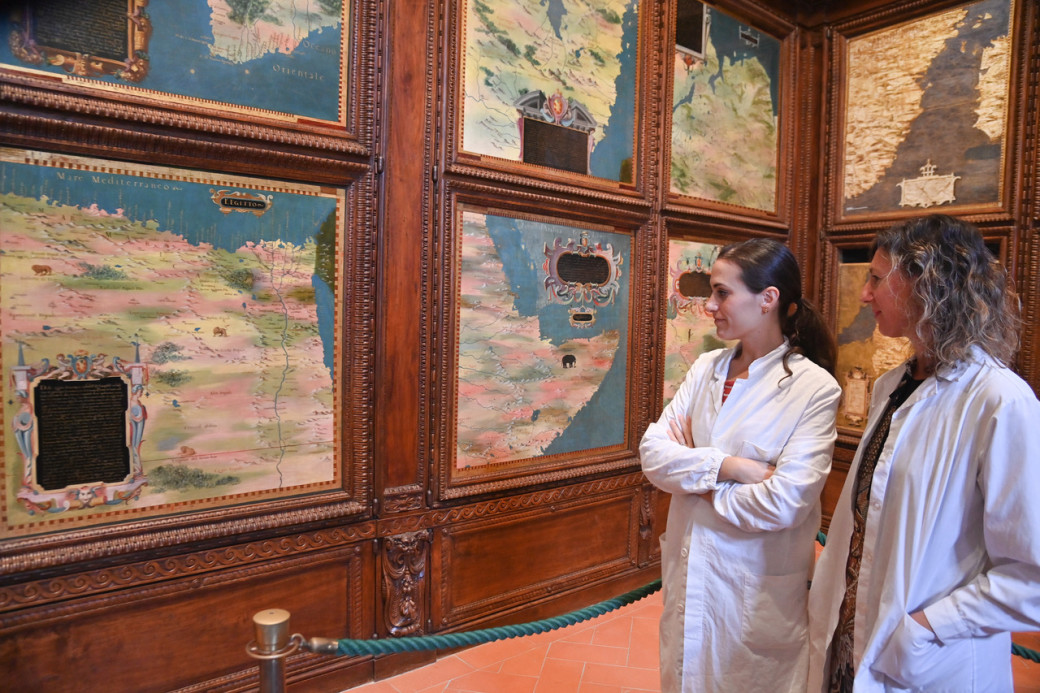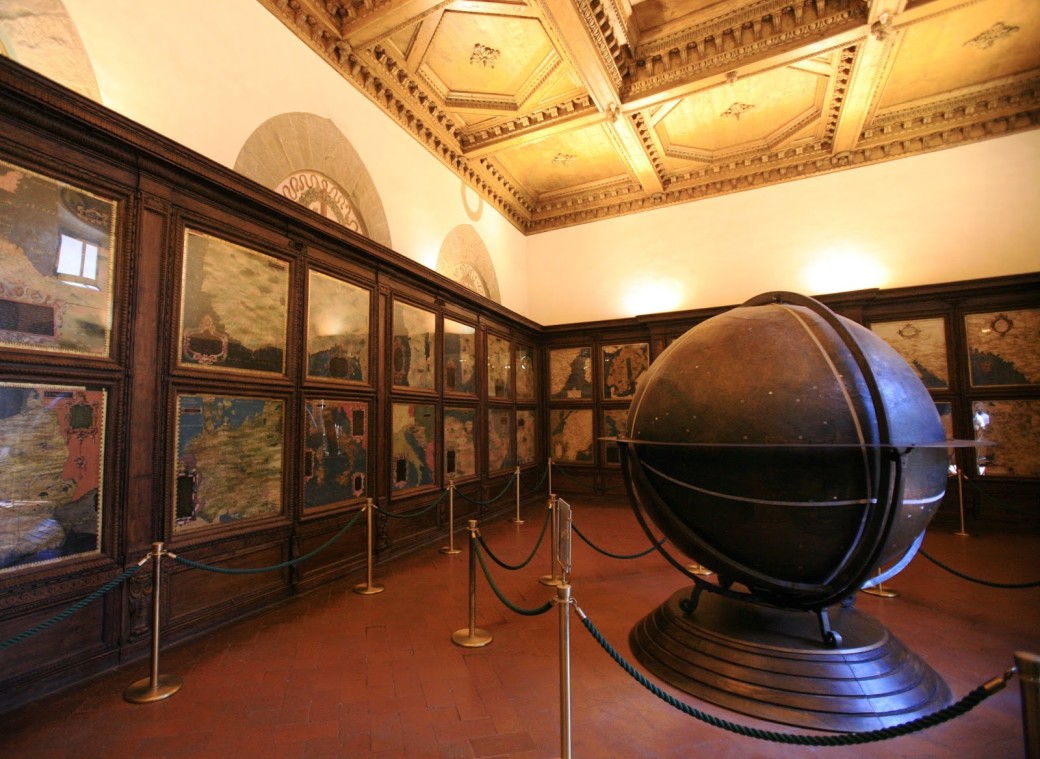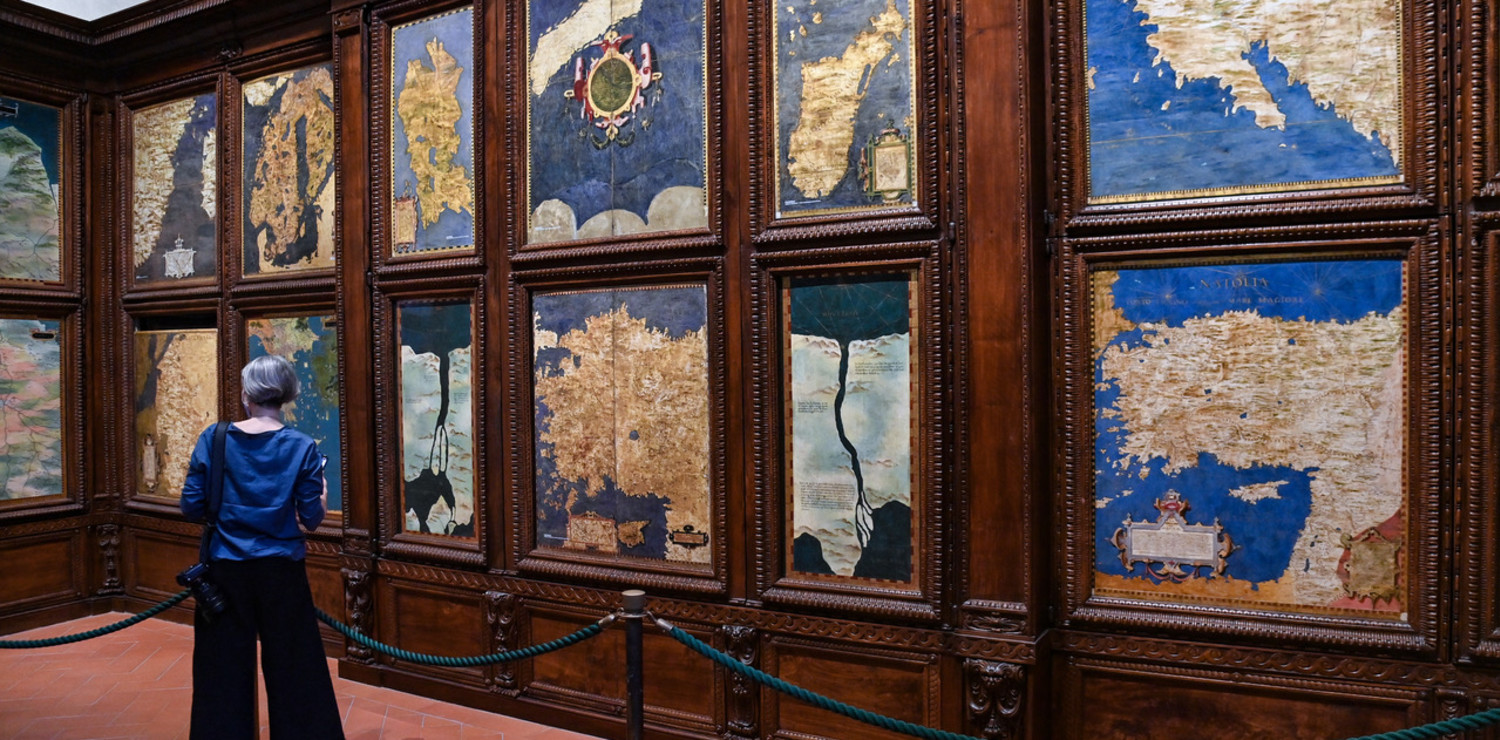The Hall of Maps in the Palazzo Vecchio
Together we discover a recently restored priceless treasure of the city and one of the oldest globes in the world
The Sala della Guardaroba in the Palazzo Vecchio museum, commonly known as the Sala delle Carte Geografiche (Map Room), reopens after a year of restoration. Thus, it is once again possible to admire the painted plates depicting the lands of Europe, Africa, Asia and the New World as they were known in the second half of the 16th century. Also nearing completion is the restoration of the globe, a monumental globe placed in the centre of the room, which is being 'curated' live under the eyes of visitors.
The maps, 53 oil paintings on wood supports, inserted in the doors of the monumental cupboards, offer a detailed representation of the lands and seas known at the time of Cosimo I, embellished with a myriad of gilded inscriptions, refined cartouches, Medici enterprises and fantastic creatures. They have been detached and restored in the adjoining room that already hosted the restoration of the putto decorating the Terrace of Juno on the third floor of the museum, recovered a year ago thanks to Friends of Florence. The mappamondo, on the other hand, which was too large to change rooms (it has a circumference of over two metres), was only moved inside as work progressed.
THE HALL OF THE GEOGRAPHIC MAPS
The sala delle Carte Geografiche was built by Giorgio Vasari between 1561 and 1565, at the request of Cosimo I, to fulfil the dual function of the main room of the Guardaroba and the cosmography room. The layout of the new room, drawn up by Vasari, included: on the ceiling, paintings depicting the constellations; along the walls, large wooden cupboards, with tables of geography on the doors and images of the fauna and flora of their respective territories on the bases; above these, busts of princes and emperors and three hundred portraits of illustrious men. Infinally, in the middle of the room, two large globes were to descend from above at the opening of the central panels of the ceiling: the celestial one, remaining suspended in the air, the terrestrial one, descending finally to the floor. The Stanza was tangible proof of Cosimo's interest in geography, natural sciences and trade, but it also concealed the duke's intent of self-celebration as ruler of the universe. The ambitious project remained partly unfinished. Of the 53 completed geographical plates, 30 were painted by the Dominican Egnazio Danti (1564-1575) and 23 by the Olivetan monk Stefano Bonsignori (1575-1586). Twenty-seven were taken from Ptolemy's Geographia (2nd century AD), updated according to modern authors, and the others, including those of America, from various more recent sources. Egnazio Danti also produced the large terrestrial globe (1564-1571), which, however, was placed elsewhere and only returned to its original destination in the last century. Cristofano dell'Altissimo also began to paint portraits of illustrious men to be placed on cabinets, copying them from Paolo Giovio's famous collection in Como. By 1570 there were already more than two hundred portraits, arranged on three files, but in the following decade they were moved to the corridor of the Galleria degli Uffizi, where they can still be seen today.
 La Sala delle Carte Geografiche a Palazzo Vecchio (ph. Carlo Bressan)
La Sala delle Carte Geografiche a Palazzo Vecchio (ph. Carlo Bressan)THE MAPPAMUND
The spectacular globe in the centre of the Sala delle Carte Geografiche (Map Room), with a diameter of approximately 220 cm, is the oldest large globe to have survived to the present day. The earliest documentary information on the globe dates back to early 1564, when we learn from a letter sent by Giorgio Vasari to Giovanni Caccini on 29 January that the latter had sent him 'the appamondo' from Pisa by river. The globe was made by the friar Egnazio Danti who had already worked on 30 geographic plates and, once finished, it is very likely that it was not placed in the Sala della Guardaroba, as it was not mentioned in the palace inventories of 1570 and 1574. Immediately placed in the Pitti Palace, where it appears in an inventory of 1587, it passed with the other scientific artefacts to the Uffizi Gallery, in 1775 to the Museum of Ancient Instruments annexed to the Specola in Florence, and only in 1958, after other vicissitudes, did it reach its original location in the Sala delle Carte Geografiche in Palazzo Vecchio.
 worldmap
worldmap








